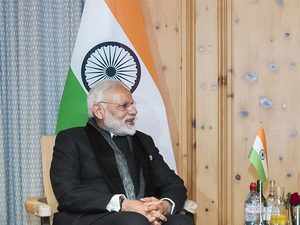By Dipanjan Roy Chaudhury ET Bureau|


India maintains that its approach in the Indo-Pacific region would remain inclusive and not hostile to any particular country.
Updated: Aug 07, 2018, 12.29 PM IST
NEW DELHI: India has stayed away from a joint initiative launched by the United States, Japan and Australia to fund infrastructure projects to counterbalance China’s Belt and Road Initiative (BRI) in the Indo-Pacific region.

Although India is part of the so-called quadrilateral or ‘Quad’ that was revived in November last year, the Modi government is simultaneously working to stabilise ties with China.
The decision not to join the US-led trilateral initiative, launched on July 30, is in keeping with India’s emphasis on multipolarity in the Indo-Pacific region and non-bloc security architecture, said people aware of the matter.
India continues to harbour serious reservations against the BRI and is keen to foster greater stability in the Indo-Pacific region, they said. But as Prime Minister Narendra Modi made it clear at the Shangri La dialogue in Singapore on June 1, India never viewed the region as “a strategy or as a club of limited members”. Earlier, during his informal summit with Russian President Vladimir Putin in Sochi, Modi emphasised on a non-bloc security architecture for the Indo-Pacific region.
The latest US-led trilateral partnership is aimed at funding projects to “build infrastructure, address development challenges, increase connectivity and promote economic growth” in the countries in the Indo-Pacific region. The US has separately committed $113 million to support digital economy, energy and infrastructure development projects in the region. It has also committed funds for security initiatives in the region.
Although India is part of the so-called quadrilateral or Quad’ that was revived in November last year, the Modi government is simultaneously working to stabilise ties with China. India and China had a series of engagements over the past few months, beginning with Modi’s “informal summit” with Chinese President Xi Jinping at Wuhan in central China on April 27-28.
The two leaders had two other meetings on the sidelines of the summits of the Shanghai Cooperation Organisation at Qingdao on east coast of China in June and the BRICS at Johannesburg in South Africa in July. India also lined up a series of engagements involving the ministers of defence, external affairs and home affairs of the two countries.

India had joined Japan, Australia and the US in November 2017 and re-launched a Quad for “consultation on Indo-Pacific”. The second meeting of the Quad was held in Singapore a couple of months ago.
India has also been holding two separate trilateral dialogues – one with the US and Japan and another with Japan and Australia – with “peace, prosperity and security” in a “free and open” Indo-Pacific being among the issues discussed in both.
India, Japan and Australia discussed discussed “strengthening regional connectivity” when they held the most recent threenation talks in Delhi in December 2017.
Besides, when the senior diplomats of India, US and Japan held the last trilateral dialogue in Delhi on April 4, they also “reviewed the outcomes of the Trilateral Infrastructure Working Group, which had met in Washington in February, and agreed to continue to collaborate to promote increased connectivity in the Indo-Pacific”.
The next round of the India-Japan-Australia trilateral is also scheduled this year and the Indo-US 2+2 dialogue in Delhi on September 6 would also focus on the Indo-Pacific region, among other issues. The US may nudge India at the 2+2 dialogue on joining the trilateral infrastructure initiative. India will also hold a separate dialogue with Russia on the Indo-Pacific region.
No comments:
Post a Comment